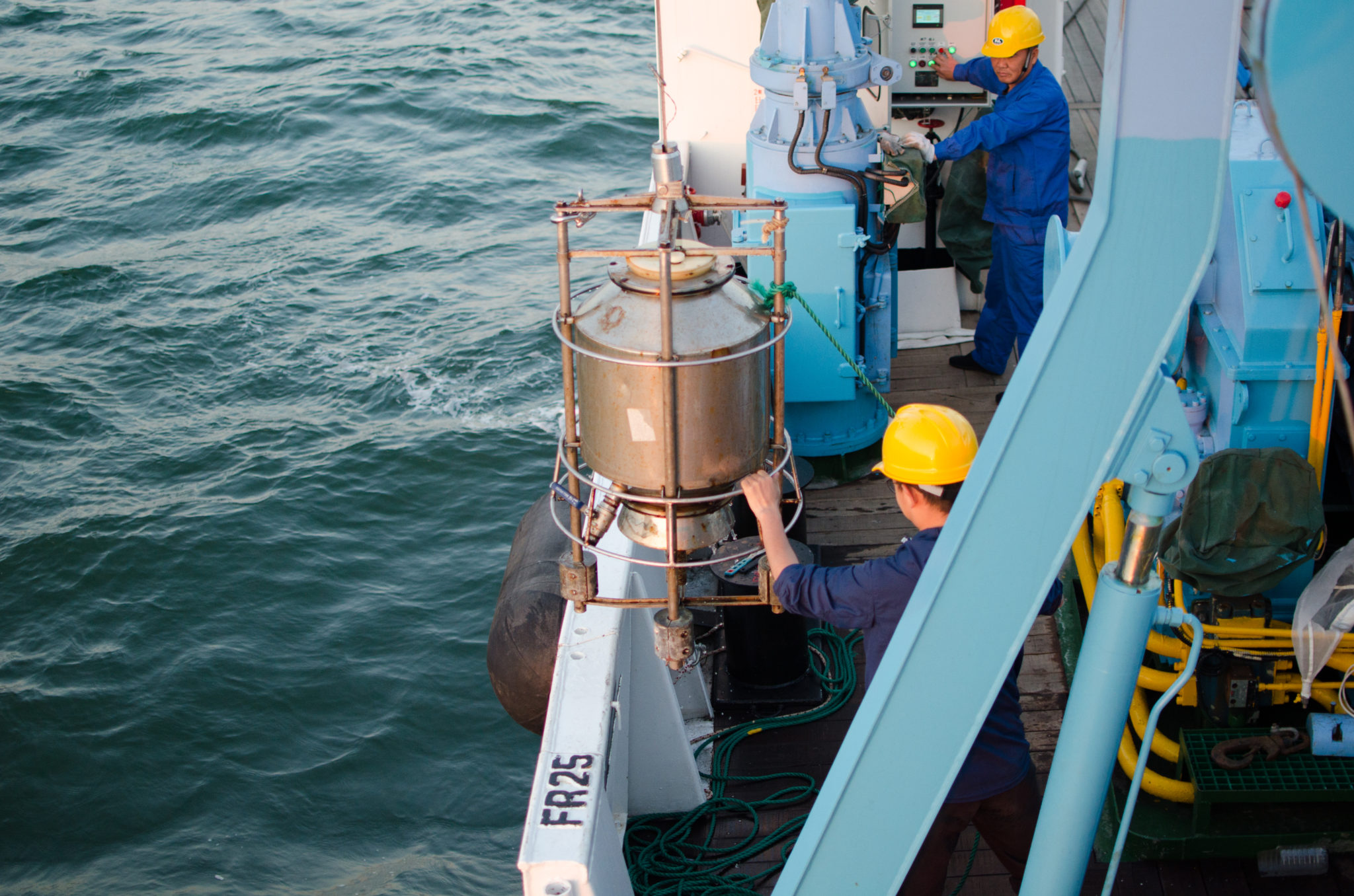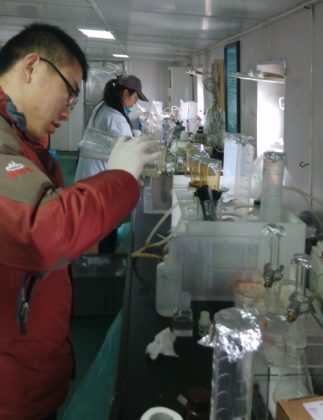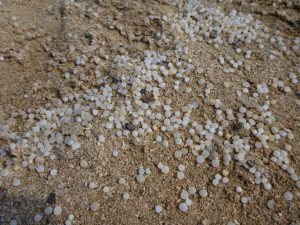As the sun rises, a survey boat drops anchor in the broad Yangtze River offshore from Shanghai’s sprawling industrial hinterland, where the world’s third longest river reaches the East China Sea. Searching for microplastics, four scientists onboard pull up their first sample water tank of the day at Xuliujing Hydrometric Station, filtering and saving any particles they find in the water.
“The purpose of the analysis of these samples is to find the spatiotemporal pattern of microplastic distribution of a major estuary in coastal China and set up a baseline data platform of microplastics for China’s estuarine and coastal area,” explains Jiang Peilin, a postgraduate student from the State Key Laboratory of Estuarine and Coastal Research (SKLEC) of East China Normal University.
Major project
The project, headed by Professor Li Daoji, an expert on marine plastics at East China Normal University, takes samples at 60 coastal sites as well as the Yangtze and Pearl rivers to estimate the quantity and distribution of microplastics in China’s coastal waters and major rivers.
Establishing such a baseline is essential if future government targets on the reduction of plastic waste are to be meaningful.
The five-year national research project receives more than 30 million yuan (US$4.6m), including 16 million yuan (US$2.6m) from central government funds, Li says.
Invisible harm from microplastics
Microplastics, or plastic particles below five millimetres in diameter, are mostly created as plastic waste degrades. Manufacturers also add microbeads or resin pellets to skin creams and body washes.
Plastic pollution is now thought to affect more than 700 marine species.
Fish and marine mammals can die from swallowing plastic bags – a whale in Thailand was recently found with more than 80 bags in its belly. However, the harm done by microplastics is slower and less visible.
Smaller marine animals can starve from ingesting the tiny pellets. Bigger creatures, higher up the food chain, may be harmed by the toxic substances absorbed by microplastics. Particles and their toxins accumulate as they rise up the food chain, and are found in fish sold for human consumption.

Research on microplastics accelerated from the early 2000s. At least 100 institutions and research centres in more than 40 countries are carrying out studies, mainly in the US, Europe, Australia, and East Asia including China, Japan and South Korea
China’s Ministry of Science and Technology and the National Natural Science Foundation funded more than 20 microplastics projects during 2015-2017.
The focus is on the ecological effect of microplastics in both freshwater and marine environments, where they come from, and how they degrade.
Xuliujing is a key research site as the Yangtze Estuary region is a major industrial and economic centre with a population of 115 million. Li’s team has gathered more than 800 water samples there since September 2016, when the five-year project began. This recent trip was their final survey.
Sampling the Yangtze
Researchers take water at four fixed spots where they sample the subsurface, middle and bottom levels every two hours. When full, each 100-litre tank is immediately filtered through extremely fine nets.
They wrap their filters in tinfoil and isolate them in separate containers before taking them to the lab for analysis.
The research plan requires taking Yangtze water samples in all four seasons, Jiang explains.

Methodology is key
The lack of a consistent and reliable method for measuring microplastics worldwide is a major issue undermining research, says Professor Li.
Different mesh sizes used in previous studies have led to significant deviations; both steel sieves and nylon plankton net have been used to collect particles.
Which particles to include is also contentious. Inclusion of clothing fibres, a significant contributor of microplastic particles, “remains contested within academic circle,” explains Li.
“Many researchers use data from different study methods without differentiating if they are comparable, which will lead to wrong conclusions,” says Li.
By obtaining systematic data from the Yangtze and Pearl rivers, Li hopes that they can provide the basis for more precise estimates of the overall quantity of microplastics for all rivers in China.
International clean up
His team is already working on a model to predict China’s contribution to microplastic pollution of the ocean.
Li says it is known that annual production of plastic products was 335 million tonnes in 2016 and rising. However, it is not known how much plastic waste comes from China. Measuring microplastics in rivers and coastal waters helps to establish an estimate.
“Apart from testifying to real marine plastic pollution made by China, this is the baseline for government making up future effective microplastic control and plastic waste management,” Li adds.
According to Li, a cooperation centre is due to be set up in ECNU in Shanghai to facilitate an international project on the distribution, source, destination and impacts of marine microplastics in the Asia Pacific Region.
Policy push
If working out the scale of the problem is tough, solving it will be much harder.
China’s central government is contributing: it has banned the import of some solid wastes including plastics; made senior local party officials into “river chiefs” personally accountable for water quality; and shoppers have been paying to use plastic bags for a decade.
Personal care products are now an international worry: the UK, Canada, the US, Australia, New Zealand and the EU have already prohibited the manufacture and import of toiletries containing plastic microbeads.
A similar legal ban was proposed at the 2018 annual meeting of the National People’s Congress in March.
Professor Li says there are simple organic alternatives to microbeads that will not impact manufacturers or lifestyles.
A policy push to replace traditional plastic bags with biodegradable ones saw China’s biodegradable plastics market grow 13% in 2016, according to a recent Research and Markets report.
Lev Neretin, senior coordinator at Northwest Pacific Action Plan, under the United Nations Environment Program, hopes China will continue to cut production of single-use plastics by considering life-span and recyclability.
“This may include setting guidelines for production design such as labelling and use of additives,” he said by email, adding that such action, “would also have impacts on exported products by lessening [the] plastics footprint.”
But change needs to happen fast.
State Post Bureau data shows that online shoppers consumed 6.8 billion plastic bags and 330 million rolls of packing tape in 2016.
With a garbage classification system yet to be established, how China will prevent all these plastics from entering the environment will be crucial.








